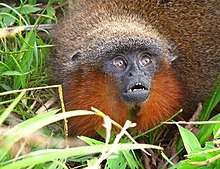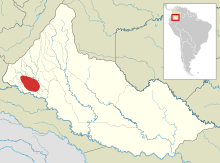Caquetá titi
The Caquetá titi, Plecturocebus caquetensis, also known as the red-bearded titi or the bushy-bearded titi, is a species of titi monkey endemic to Colombia found in the Department of Caquetá region.[1][3] Taxonomically, it is a member of the "Callicebus cupreus group" (now Plecturocebus cupreus), following Shunsuke Kobayashi's Callicebus grouping. It was first described by Thomas Defler, Marta Bueno and Javier Garcia in 2010.[1] It is highly endangered due to habitat fragmentation and a small population.[1]
| Caquetá titi[1] | |
|---|---|
 | |
| Scientific classification | |
| Kingdom: | Animalia |
| Phylum: | Chordata |
| Class: | Mammalia |
| Order: | Primates |
| Suborder: | Haplorhini |
| Infraorder: | Simiiformes |
| Family: | Pitheciidae |
| Genus: | Plecturocebus |
| Species: | P. caquetensis |
| Binomial name | |
| Plecturocebus caquetensis Defler, et al., 2010 | |
 | |
| P. caquetensis on map of Caquetá department, Colombia | |
| Synonyms | |
|
Callicebus caquetensis | |
Description
Its fur is generally brown, with a lighter tail and chestnut-red undersides, neck and cheeks. It is similar in appearance to the ornate titi and white-tailed titi except that it does not have a white forehead bar, nor does it have the white hands and feet of the ornate titi.[1] It also has a red beard.[4] It has 22 chromosome pairs (not counting the sex chromosomes), with a diploid chromosome number of 2n=46.[1]
Conservation
In the paper describing the species, the authors recommend that the species be classified as critically endangered by the International Union for Conservation of Nature (IUCN). According to the authors' estimate, the population size of the species may be fewer than 250 adult animals.[1] It lives in forests fragmented by agricultural activity, and dispersal is hazardous since it must cross open savanna or barbed wire in order to reach new nearby forest fragments. The species has a geographic range of just about 100 square kilometers (39 sq mi) and actually occupies only about 10 square kilometers (3.9 sq mi) within that range.[1]
Biology
All 13 groups studied consisted of a single adult male, a single adult female and between one and four immature monkeys.[1] Average group size, including adults and immatures, was 4.1 monkeys.[1] This is consistent with other titi monkey species, which form small, cohesive groups led by a bonded pair of adults.[5] Like other titi monkey species, they are monogamous and pairs raise about one baby each year.[6] Babies make purring noises similar to cats when they are content.[6] Titi monkey diets typically consist primarily of fruit, with leaves the second most important food item, and with seeds forming only a small portion of the diet.[5]
References
- Defler, Thomas R.; Bueno, Marta; Garcia, Javier (2010). "Callicebus caquetensis: A New and Critically Endangered Titi Monkey from Southern Caquetá, Colombia". Primate Conservation. 136211. Archived from the original on 2011-07-26. Retrieved 2010-07-18.
- Defler, T. R. & García, J. (2012). "Plecturocebus caquetensis". IUCN Red List of Threatened Species. 2012. Retrieved 23 June 2012.CS1 maint: ref=harv (link)
- Stevenson, Pablo R.; Guzmán, Diana C.; Defler, Thomas R. (2010). "Conservation of Colombian primates: an analysis of published research" (PDF). Tropical Conservation Science. 3 (1): 45–62.
- "New titi monkey, at last". ScienceNews. August 12, 2010. Archived from the original on August 15, 2010. Retrieved 2010-08-13.
- Norconk, M. (2007). "Sakis, Uakaris and Titi Monkeys". In Campbell, C.; Fuentes, A.; MacKinnon, K.; Panger, M.; Bearder, S. (eds.). Primates in Perspective. Oxford University Press. pp. 123–138. ISBN 978-0-19-517133-4.
- "Rare Redbearded Monkeys Found Living in Colombia". CBS News. August 13, 2010. Retrieved 2010-08-13.
